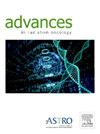Computed Tomography Scan Planning in Radiation Oncology: Prospective Evaluation of the “Mini-CT Scan” Procedure Prior to a Routine Immediate Planning Computed Tomography Scan Practice. Results of the OPTIMAL Study
IF 2.7
Q3 ONCOLOGY
引用次数: 0
Abstract
Purpose
To determine the benefit/risk in terms of radioprotection of performing a mini-computed tomography (CT) scan prior to the planning CT scan in patients requiring pelvic irradiation. The study population included patients who received curative intent external beam radiation therapy for pelvic malignancies. The results are applicable to all supine pelvic external beam radiation therapy patients.
Methods and Materials
Between April 9, 2021, and October 5, 2021, 53 patients were included in the study. A mini-CT scan was performed for each patient to determine whether they were properly prepared with a full bladder and empty rectum for the planning CT scan. Depending on the result, it was decided to either perform the planning CT scan or repeat a mini scan after rectal enema and drinking to better empty the rectum and fill the bladder. Up to 3 mini scans could be performed, after which a new CT appointment was scheduled if the patient was considered not sufficiently prepared.
Results
Among the 53 patients included in the study, 64 wide CT scans were performed (average, 1.2 scans per patient). A total of 47, 3, 2, and 1 patients were treated for prostate, rectal, bladder, and anal canal cancers, respectively. The median age was 75 years (range, 57-94), with 51 men and 2 women. For 29 patients, a single mini-CT scan was performed prior to the wide CT scan, corresponding to an additional mean effective dose of 2.3 mSv to the mini-CT scan. For 25 patients, multiple wide CT scans and mini-CT scans were performed. For these patients, the mini-CT scan allowed us to decrease patient exposure by reducing the average effective dose by 22.1 mSv per patient. The systematic use of a mini-CT scan in the whole cohort allowed reducing the mean effective dose by 9.44 mSv based on a paired t test (P < .0001).
Conclusions
We demonstrated that the effective dose delivered to the patient was significantly lower if we carried out 1 or more mini-CT scans to avoid doing iterative planning CT scans that deliver a higher dose to the patient.
放射肿瘤学中的计算机断层扫描计划:在常规立即计划计算机断层扫描实践之前对“迷你ct扫描”程序的前瞻性评估。优化研究的结果
目的探讨在需要骨盆放射治疗的患者进行计划CT扫描前进行微型计算机断层扫描(CT)对放射防护的益处/风险。研究人群包括接受盆腔恶性肿瘤外束放射治疗的患者。结果适用于所有仰卧位骨盆外束放疗患者。方法与材料在2021年4月9日至2021年10月5日期间,53例患者被纳入研究。对每位患者进行迷你CT扫描,以确定他们是否为计划的CT扫描准备了充分的膀胱和空直肠。根据结果,决定在直肠灌肠和饮水后进行计划CT扫描或重复迷你扫描,以更好地清空直肠和填充膀胱。最多可进行3次迷你扫描,如果认为患者准备不足,则安排新的CT预约。结果在纳入研究的53例患者中,进行了64次宽CT扫描(平均每位患者1.2次扫描)。前列腺癌、直肠癌、膀胱癌和肛管癌患者分别为47例、3例、2例和1例。中位年龄为75岁(57-94岁),男性51人,女性2人。对于29例患者,在宽CT扫描之前进行了单次迷你CT扫描,对应于迷你CT扫描的额外平均有效剂量为2.3毫西弗。对25例患者进行了多次宽CT扫描和迷你CT扫描。对于这些患者,mini-CT扫描使我们能够通过将每位患者的平均有效剂量降低22.1 mSv来减少患者的暴露。根据配对t检验,在整个队列中系统地使用微型ct扫描使平均有效剂量减少了9.44毫西弗。。)。我们证明,如果我们进行1次或更多的迷你CT扫描,以避免重复计划CT扫描,向患者提供更高的剂量,则传递给患者的有效剂量显着降低。
本文章由计算机程序翻译,如有差异,请以英文原文为准。
求助全文
约1分钟内获得全文
求助全文
来源期刊

Advances in Radiation Oncology
Medicine-Radiology, Nuclear Medicine and Imaging
CiteScore
4.60
自引率
4.30%
发文量
208
审稿时长
98 days
期刊介绍:
The purpose of Advances is to provide information for clinicians who use radiation therapy by publishing: Clinical trial reports and reanalyses. Basic science original reports. Manuscripts examining health services research, comparative and cost effectiveness research, and systematic reviews. Case reports documenting unusual problems and solutions. High quality multi and single institutional series, as well as other novel retrospective hypothesis generating series. Timely critical reviews on important topics in radiation oncology, such as side effects. Articles reporting the natural history of disease and patterns of failure, particularly as they relate to treatment volume delineation. Articles on safety and quality in radiation therapy. Essays on clinical experience. Articles on practice transformation in radiation oncology, in particular: Aspects of health policy that may impact the future practice of radiation oncology. How information technology, such as data analytics and systems innovations, will change radiation oncology practice. Articles on imaging as they relate to radiation therapy treatment.
 求助内容:
求助内容: 应助结果提醒方式:
应助结果提醒方式:


